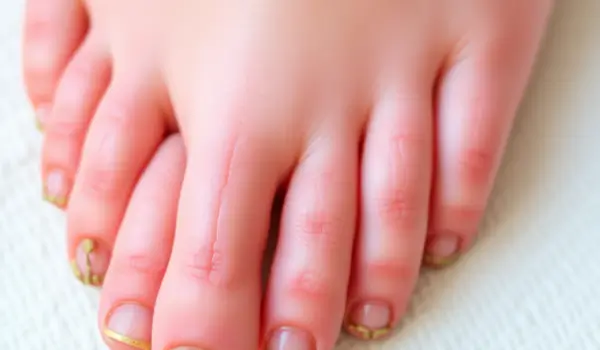Is Toenail Fungus Contagious? Toenail fungus is one of those pesky and frustrating conditions that many people struggle with, yet few truly understand.
If you’ve ever noticed thick, discolored, brittle nails, you might be dealing with a fungal infection. But here’s the million-dollar question: Is toenail fungus contagious? Can you catch it from someone else, or are your feet just unlucky? The answers may shock you!

Fungal infections are more common than you think, and yes, they can spread! Whether you’ve been wondering about toenail fungus transmission through nail salons, shared showers, or even something as simple as socks, we’ve got you covered. In this article, we’ll break down the science behind toenail fungus, how it spreads, and most importantly, how to prevent and stop toenail fungus from spreading to your loved ones. Let’s dive in!
Is Toenail Fungus Contagious? Here’s What Science Says!
Yes, is contagious! According to medical research, toenail fungus, also known as onychomycosis, is caused by fungal organisms called dermatophytes. These fungi thrive in warm, moist environments and spread through direct and indirect contact.
Studies show that fungal spores can survive on surfaces for weeks, making it easy for infections to pass from person to person. If you’ve ever shared a shower, worn someone else’s shoes, or even walked barefoot in public places, you may have unknowingly exposed yourself to a contagious toenail fungus infection.
But here’s the twist: while toenail fungus can be contagious, not everyone is equally susceptible. Factors like weakened immunity, age, poor hygiene, and existing nail damage increase the risk of infection. Understanding how toenail fungus spreads can help you take action before it’s too late!
How Does Spread? The Surprising Ways You’re at Risk
Fungal infections don’t just magically appear—they spread in sneaky ways that you might not expect. Here are some of the most common ways toenail fungus transmission occurs:
- Direct Contact: If you touch an infected toenail, you risk transferring the fungus to your own nails.
- Public Showers & Swimming Pools: Wet, warm environments are breeding grounds for fungal spores.
- Shared Footwear: Borrowing someone else’s shoes or slippers? You might also be borrowing their fungus.
- Unsterilized Nail Tools: Nail salons that don’t properly disinfect tools can unknowingly spread toenail fungus.
- Sweaty Shoes & Socks: Fungi love dark, damp places, making sweaty shoes a perfect home for infections.
If you recognize any of these risky behaviors in your daily life, don’t panic! Preventing toenail fungus spread is possible with a few simple lifestyle changes.
Toenail Fungus Transmission: Can It Jump from One Person to Another?
Absolutely! spreads from person to person through both direct and indirect contact. If you live with someone who has, you’re at higher risk of getting it yourself.
How does this happen?
- Walking barefoot on shared floors (bathrooms, carpets, gyms)
- Touching infected toenails and then touching your own feet
- Using the same towels or nail clippers as an infected person
The best way to stop toenail fungus from spreading is by maintaining good foot hygiene and avoiding contact with contaminated surfaces.
Can You Catch from Someone Else? The Truth Uncovered!
Yes, you can! Toenail fungus doesn’t just affect the elderly or those with poor foot hygiene—anyone can catch it. The risk is especially high for people who:
- Have weak immune systems
- Frequent public pools, gyms, or locker rooms
- Regularly get pedicures at unregulated nail salons
To protect yourself, avoid walking barefoot in public spaces, disinfect your nail tools, and never share footwear.
Toenail Fungus Infection Contagious: How It Takes Over Your Nails
A contagious toenail fungus infection starts small—often as a tiny white or yellow spot on the nail. But if left untreated, it quickly spreads, causing nails to become thick, brittle, and discolored. In severe cases, the nail may separate from the nail bed, leading to pain and discomfort.
The scary part? Once the fungus gets under your nail, it’s tough to eliminate. That’s why it’s crucial to treat early and aggressively.
Try This Product: ProNail Complex Reviews: Real Results You Can Trust
Can Spread Through Nail Polish? What You Need to Know!
Yes! Nail polish can act as a breeding ground for fungus, trapping moisture and making it easier for the infection to thrive. If you use the same polish or tools as someone with an infection, you risk spreading it to your own nails.
Protect yourself by:
- Using antifungal nail polish
- Avoiding shared nail tools
- Keeping nails clean and dry
Toenail Fungus Contagious Period: How Long Are You at Risk?
Fungal infections don’t go away overnight! Without treatment, can remain contagious for months or even years. The longer you leave it untreated, the higher the chance of spreading it to others.

Preventing Spread: Game-Changing Tips for Healthy Feet
- Keep feet clean and dry
- Change socks daily
- Wear breathable shoes
- Disinfect nail clippers after each use
- Use antifungal foot powder
How to Stop Toenail Fungus from Spreading and Protect Your Loved Ones
- Treat infections as soon as possible
- Avoid sharing towels, shoes, and socks
- Use antifungal creams and sprays
Spread Through Socks and Shoes: Are You Making This Mistake?
Fungus thrives in damp, enclosed spaces—like sweaty socks and tight shoes. To prevent reinfection:
- Wear moisture-wicking socks
- Rotate your shoes to allow them to air out
- Spray shoes with antifungal spray regularly
Conclusion
Toenail fungus is more than just an unsightly nuisance—it’s a contagious infection that can spread rapidly if not managed properly. But now that you know the shocking truth about toenail fungus transmission, you can take action!
By following the preventative tips and maintaining good foot hygiene, you can keep your nails healthy and fungus-free. Don’t let take over—fight back today! 🚀
Try This Product: AppaNail Reviews: Is It Safe And Worth Trying?
Frequently Asked Questions
1. Is toenail fungus contagious?
Yes, is highly contagious and can spread through direct contact with infected nails or contaminated surfaces like floors, shoes, and socks.
2. How does toenail fungus spread?
spreads through contact with fungal spores found in damp environments such as public showers, swimming pools, locker rooms, and even shared footwear.
3. Can you catch toenail fungus from someone else?
Yes, you can catch from an infected person by sharing personal items like socks, shoes, nail clippers, or towels.
4. Can spread through nail polish?
While the risk is low, fungal spores can linger on nail polish brushes and bottles, making it possible to transfer the infection if using contaminated polish.
5. How long is toenail fungus contagious?
remains contagious as long as the infection is active. Even after symptoms improve, fungal spores can persist and spread if proper hygiene and treatment are not maintained.
6. Can toenail fungus spread through socks and shoes?
Yes, fungus thrives in warm, moist environments, making socks and shoes a common medium for transmission, especially if they are shared or not regularly cleaned.
7. Is toenail fungus contagious to children?
Yes, although children are less likely to develop, they can still contract it through exposure to infected family members or contaminated surfaces.
8. How can I prevent the spread of toenail fungus?
To prevent spreading, avoid sharing personal hygiene items, wear protective footwear in public areas, keep feet dry, and disinfect shoes and nail tools regularly.
9. How do I stop toenail fungus from spreading to other nails?
Trim infected nails carefully, wash hands after touching infected areas, apply antifungal treatments as prescribed, and keep feet clean and dry.
10. Can toenail fungus go away on its own?
rarely resolves on its own. It often requires medical treatment, such as topical or oral antifungal medications, and consistent foot hygiene to prevent recurrence.
